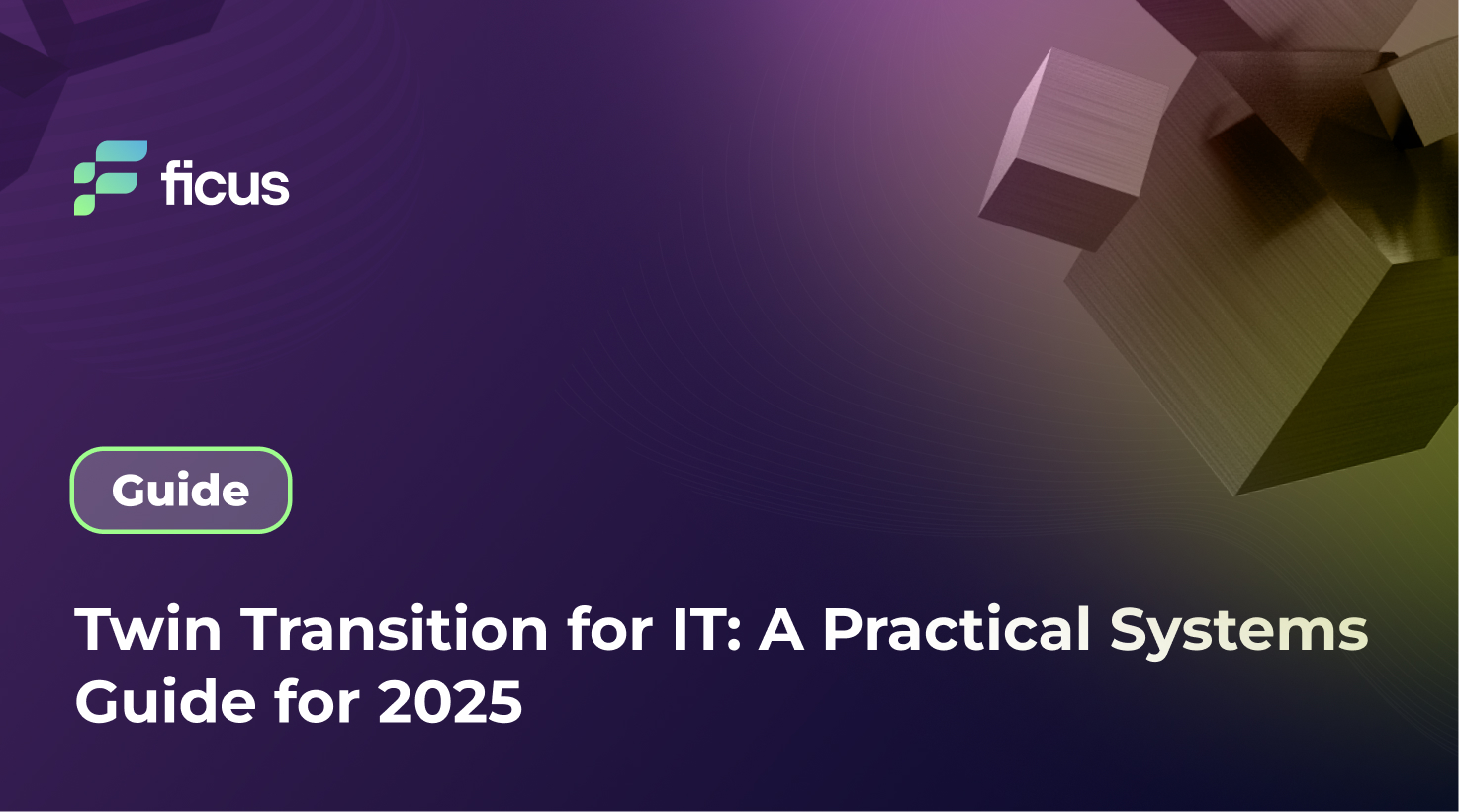Using human resource information system software reduces time spent on manual chores and streamlines personnel management by combining pertinent data. This efficiency increase is essential for businesses looking to maximize their HR operations. As an HRIS enables the HR staff to use their abilities more effectively and transition from administrative duties to strategic responsibilities, it becomes a vital tool. This article explains the critical benefits of using HRIS software early on and the main factors to consider when choosing the best HRIS for your business to ensure alignment with your goals for growth and demands.
- HRIS systems improve efficiency, data management, and strategic HR planning.
- Selecting suitable HRIS software requires evaluating specific business needs and goals.
- Ficus Technologies offers customized HRIS solutions for diverse organizational requirements.
What is an HRIS?
A human resource information system (HRIS) is software that combines human resources activities with information technology. It is a centralized database that manages employee data, including demographics, leave balances, attendance, and benefits. HRIS facilitates effective onboarding, employee data management, and compliance with legal standards, which can be accessed remotely with appropriate permissions. This system allows HR professionals to improve workflow efficiency and effectively manage staff. HRIS supports informed decision-making in HR processes by automating record-keeping and data analysis.

Why is an HRIS important?
HRIS software is essential for reducing mistakes, removing the need for manual processes, and optimizing HR operations. These tools provide swift access to organized data, enabling quick report generation that aids in strategic decision-making. HRIS assists in preemptively addressing challenges such as employee turnover, recognition, diversity, and performance management by facilitating a detailed view of the organizational structure and employee performance. Furthermore, continual updates ensure these systems evolve with technological advancements, maintaining efficiency in HR processes. This adaptability ensures organizations and their employees remain updated, optimizing HR management efficiency.
I am convinced that nothing we do is more important than hiring and developing people. At the end of the day, you bet on people, not on strategies.
Lawrence Bossidy
What are the types of HRIS?
The choice of a human resource information system (HRIS) directly influences the administration of HR jobs. Four main types of HRIS satisfy certain organizational requirements:
- Operational HRIS assists with inner staff member data management, aiding in decision-making procedures related to human resources operations.
- Tactical HRIS enhances source allowance for employment, job layout, and staff member growth, improving talent monitoring.
- Strategic HRIS supplies insights for aligning HR objectives with the organization’s mission, helping with effective labor force planning.
- Comprehensive HRIS incorporates all HR operations into a single platform, supplying a combined option for managing employee information and human resources procedures.
What are the benefits of an HRIS?
Embracing a human resource information system uses transformative benefits for companies by enhancing HR jobs and operational efficiency. Trick benefits include:
- Performance: Automates routine jobs, enabling focus on calculated problems such as employee advancement and diversity initiatives. This simplifies operations and enhances decision-making procedures.
- Staff member experience: It makes it possible for staff to handle HR-related tasks with mobile systems, streamlining processes from onboarding to leave, enhancing satisfaction.
- Decreased documents: Changing HR operations to electronic means reducing manual documentation for jobs like recruitment and efficiency administration, conserving time and resources.
- Conformity: Normal updates from human resource information system software guarantee adherence to legal criteria, streamline conformity with policies, and reduce mistakes.
What is the difference between an HRIS and an HRMS?
HRIS systems provide the core of employee information management, concentrating on duties including payroll, data administration, and attendance monitoring. This solution effectively manages fundamental employee-related procedures by streamlining administrative HR activities. However, as HRIS software evolves into an HRMS (Human Resource Management System), it incorporates a wider range of HR features. With the addition of talent management and strategic HR functions, including hiring, performance evaluation, and staff training, this expansion provides a more comprehensive approach to human resource management.
Unlock Your Ideal HRIS Fit with Ficus Technologies!
Contact Us6 Factors to Consider When Selecting an HRIS
Choosing the appropriate Human Resource Information System (HRIS) requires careful consideration. The upcoming sections explore 6 vital variables to review, helping you pick an HRIS that best supports your business’s functional and tactical goals.
- HRIS Features
Picking the ideal HRIS entails assessing the HRIS features that meet your organizational demands.
Recruitment/applicant monitoring: Successfully handled work applications and candidates.
E-Verify and background checks: Ensure conformity and protection in hiring.
Onboarding: Simplify the intro of new employees.
Benefits enrollment: Simplify the procedure for staff members to sign up with firm benefit programs.
Performance assessments: Help with the assessment of staff member efficiency.
Position and payment administration: Arrange and change duties and salaries efficiently.
Staff member self-service: Encourage staff members to access and handle their individual information.
Conducting a requirements analysis before choosing an HRIS system or HRIS software program is needed to straighten the system’s abilities with both present and anticipated demands. This step guides whether to start with a fundamental configuration that can expand or to pick an extensive human resource information system software plan at first. Guaranteeing the selected HRIS lines up with your critical objectives supports reliable human resources monitoring.
- Technology requirements
Recognizing the appropriate human resource information system requires straightening it to fit the company’s demands and framework. Cloud-based systems provide scalability and decreased IT, making them an eye-catching option for several companies. Integration abilities are essential to ensure smooth operation with existing tools and systems, preventing the requirement for pricey replacements or modifications. Additionally, durable protection features are non-negotiable due to the sensitive nature of HR information, needing thorough vetting of vendors’ safety steps to stop information breaches and ensure compliance with data protection laws.
- Cost
The human resource information system (HRIS) cost usually consists of a per staff member per month (PEPM) charge, varying from $1 to $15 based on the features. Fundamental HRIS systems are at the lower end of this range, with expenses climbing for added functions. Discussing all costs with providers, including any possible one-time setup fees for configuration and maintenance, is critical to staying within the budget.
- HRIS Implementation
The implementation of a human resource information system (HRIS) must minimize disturbance to day-to-day activities, allowing for a focus on business development. Ensuring the provider outlines a clear, succinct preparation for implementation that respects operational continuity is necessary. Selecting a provider that prioritizes your particular demands over a generic rollout strategy and offers hands-on management to maximize system advantages directly influences efficiency and task automation. Inquiry into their support of high quality via recommendations from organizations that have experienced their application procedure affords beneficial insights.
- Support
After HRIS implementation, continual assistance comes to be vital. Making sure that the selected company provides consistent, dedicated support for the HRIS systems is essential. This involves accessibility to educated experts familiar with the customer’s particular arrangement and more comprehensive system capabilities. Such assistance promotes maximum utility from the HRIS, attending to any kind of fostering challenges and giving updates on new attributes or system enhancements. This technique boosts functional effectiveness and ensures the HRIS progresses in alignment with changing service needs and technology improvements.
- Scalability
A scalable HRIS system assists company development, helping with assimilation with existing traditional systems and rising modern technologies such as straight provider links, accounting/ERP systems, job costing applications, and eLearning programs. This capacity to adapt prevents the requirement for platform adjustments to get new functionalities, helping achieve tactical goals. By choosing an HRIS software application that offers many more capacities than is currently required, organizations can fully take advantage of the system’s potential as it increases, ensuring individual interaction through a user-friendly user interface that takes full advantage of device usage for continuous operational effectiveness.
When does your company need an HRIS?
Your business requires an HRIS if:
- Worker matters arise—Handling human resources procedures by hand or on spreadsheets is difficult and error-prone with more than 50 staff members, increasing the chance of conformity issues and employee discontentment. HRIS software streamlines information companies across numerous human resources features.
- Using multiple systems—Fragmented systems for IT recruitment, attendance, and payroll decrease productivity. An integrated HRIS consolidates these processes, enhancing efficiency and providing comprehensive workforce insights.
- Enhancing employee experience—As staff member experience becomes a priority, an HRIS can significantly enhance company culture, interaction, openness, and collaboration, promoting a positive employee-employer partnership.
7 Steps to Select the Best HRIS
Finding the best HRIS requires a methodical process. The seven essential actions outlined in this paragraph will help firms achieve an HRIS that fits their goals and increases operational efficiency. Follow these guidelines to ensure your selection process is effective and aligned with your organizational goals.
Step 1: Initial Assessment
The first action in embracing an HRIS system includes identifying the most appropriate team for the choice process. This could be an inner HR team or an outside consultant. Small HR groups or those unfamiliar with HRIS software application choice may locate stabilizing normal responsibilities and the option procedure overwhelming, making the engagement of professionals useful. On the other hand, bigger HR divisions may look for external insights to affirm their internal analyses, ensuring the chosen human resource details system lines up completely with the organization’s needs and objectives, thus assisting in a much more informed decision-making procedure.
Step 2: Determine Organizational Needs
The right HRIS software should be chosen after determining the company’s special needs. Identifying desirable traits but not required from those essential is the task of this stage. Typical beginning points include seeking an HRIS system with an incorporated payroll module or compatibility with existing payroll systems. Essential enhancements commonly include candidate tracking, efficiency management, and time attendance systems. Given the complexities of benefits administration, incorporating an advantages module proves useful for tracking registrations and conformity. Moreover, a Staff Member Self-Service (ESS) module improves efficiency by allowing staff to upgrade personal information directly.
Step 3: Evaluating Available Vendors to Your Company Needs
Evaluating vendors versus your company’s needs entails comparing human resource information system software choices with a tailored standards list. Create a spreadsheet noting your specific requirements, such as integration with payroll systems, performance management, and timekeeping on one axis and prospective suppliers on the other. This approach systematically evaluates each human resource information system software against critical functionalities like advantages management, worker self-service, and sequence preparation. It guarantees a comprehensive analysis of reporting capabilities, onboarding procedures, and monthly and total expenses, enabling an educated choice that complies with corporate standards.
Step 4: Create Your Project Committee
Representatives from several departments, including senior management, IT, payroll/finance/accounting, compensation, recruiting, and operations, are needed when creating a project committee to choose the human resource information system software. This guarantees a thorough assessment from different operational angles, enabling a choice that aligns with the company’s demands both now and in the future. With the varied perspectives of the committee, a human resource information system software solution that meets the company’s goals is identified, improving overall effectiveness and efficiency.
Step 5: Request for Proposal (RFP)
Purchasing human resource information system software requires a crucial step, such as sending a Request for Proposal (RFP) to chosen providers. Through this procedure, you can be confident that the suppliers know your organization’s demands, project specifications, minimum requirements, financial restrictions, and implementation and selection timetable. Your company may compare and contrast products by requesting specific quotes, which will help you ensure the human resource information system software you choose will work within your budget and goals. Sending out requests for proposals (RFPs) to at least four suppliers enhances the likelihood of discovering a solution that meets certain organizational requirements.
Step 6: Demonstration and Evaluation
After receiving RFP responses, selecting at least four vendors for on-site demonstrations of their HRIS systems allows a direct comparison with the organization’s needs. This makes it possible to assess each HRIS system’s suitability for meeting predetermined standards. The project committee’s participation in these presentations makes it easier to conduct a thorough investigation into the operation of each system. A systematic evaluation is facilitated using a checklist based on the desired and minimal requirements. This procedure verifies that the selected HRIS system aligns with the company’s objectives and aids in the early detection of any problems. Following the demonstration, a debriefing session promotes group analysis and decision-making, guaranteeing an educated selection.
Step 7: Choosing Between the Final Vendors
After selecting the best HRIS systems, reference checks are carried out on the remaining choices to confirm their dependability and performance based on the feedback from current users. This crucial stage ensures that the chosen HRIS system not only satisfies the organizational needs in theory but also functions well in practical implementations. The selection committee’s last conference to contrast reference comments with initial scorecard assessments permits an extensive analysis, making certain a knowledgeable decision. Senior management may receive a fully evaluated recommendation highlighting the strategic value and expected advantages at the end of the process.
Final thoughts
For businesses of all sizes, determining and putting the best possible human resource information system (HRIS) in place greatly improves operational efficiency by allowing for more efficient workflows, improved data management, and a strong platform for strategic HR initiatives. You may choose an HRIS software that successfully supports your aims and ensures a more engaged and productive staff by carefully assessing your company’s unique demands, present infrastructure, and future aspirations.
Ficus Technologies is an expert in negotiating the intricacies of HRIS systems and provides customized solutions that meet your particular company’s needs. With creative human resource information system software solutions, our experience can revolutionize your HR processes and enable your company to reach its maximum potential.
Identify your organization’s specific needs and priorities to successfully select and implement a human resources information system (HRIS). Build a cross-functional team to ensure that all HR and business requirements are addressed. Find vendors that offer solutions that meet your criteria and shortlist them. Request demos and thoroughly review their offerings against your requirements checklist. Conduct reference checks on the final candidates to confirm their performance and support services. Once selected, plan a structured implementation process, including data migration, system setup, and user training. Involve stakeholders throughout the process to get feedback and adjust the system to support your HR operations effectively.u003cbru003e
Evaluating an effective HRIS involves looking at its ability to meet your organization’s specific needs. Key factors include the system’s scalability, user-friendliness, and features, such as payroll, benefits administration, and compliance management. Evaluate the system’s ability to integrate with other software used in your company. Pay attention to the quality of customer support and the vendor’s reputation for reliability. In addition, the cost-benefit ratio should be analyzed to ensure the system provides the best value for money. Finally, get feedback from end users to evaluate the system’s effectiveness in optimizing HR processes and improving the overall efficiency of the HR department.u003cbru003e








